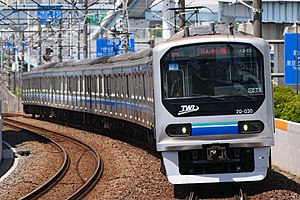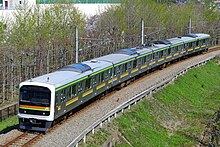TWR 70-000 series
| Tokyo Waterfront Area Rapid Transit 70-000 series | |
|---|---|
 Set Z3 in June 2022 | |
| In service | 1996–Present |
| Manufacturer | Kawasaki Heavy Industries |
| Constructed | 1995–2004 |
| Refurbished | 2011–2018 |
| Number built | 86 vehicles |
| Number in service | 80 vehicles (8 sets) (+6 vehicles converted to 209-3100 series) |
| Successor | TWR 71-000 series |
| Formation | 10 cars per trainset |
| Fleet numbers | Z1–3, Z6–10 |
| Operators | Tokyo Waterfront Area Rapid Transit |
| Depots | Yashio Depot |
| Lines served |
|
| Specifications | |
| Car body construction | Stainless steel |
| Train length | 200.84 m (658 ft 11 in) |
| Car length | 20.42 m (67 ft 0 in) (end cars) 20 m (65 ft 7 in) (intermediate cars) |
| Width | 2.8 m (9 ft 2 in) |
| Height | 4,067 mm (13 ft 4.1 in) |
| Doors | Sliding, 4 pairs per side |
| Maximum speed | 110 km/h (68 mph) |
| Electric system(s) | 1,500 V DC overhead catenary |
| Current collector(s) | Pantograph |
| Safety system(s) | ATS-P, ATC |
| Track gauge | 1,067 mm (3 ft 6 in) |
The Tokyo Waterfront Area Rapid Transit 70-000 series (東京臨海高速鉄道70-000形) is a DC commuter electric multiple unit (EMU) train type operated in the Tokyo area of Japan by the Tokyo Waterfront Area Rapid Transit. The train was built by Kawasaki Heavy Industries and first entered revenue service in 1996. Its design is based on the 209 series.
Formations[edit]
As of 1 April 2011[update], eight 10-car sets, numbered Z1 to Z3 and Z6 to Z10, are based at Yashio Depot in Tokyo (accessed via a spur located between Tennōzu Isle Station and Tokyo Teleport Station). These sets are formed as follows with six motored ("M") cars and four non-powered trailer ("T") cars.[1]
← Shin-Kiba Ōsaki, Ōmiya, Kawagoe →
| ||||||||||
| Car No. | 10 | 9 | 8 | 7 | 6 | 5 | 4 | 3 | 2 | 1 |
|---|---|---|---|---|---|---|---|---|---|---|
| Designation | Tc2A | M1A | M2A | T2A | M1A | M2B | T2A | M1A | M2A | Tc2B |
| Numbering | 70-xx0 | 70-xx1 | 70-xx2 | 70-xx3 | 70-xx4 | 70-xx5 | 70-xx6 | 70-xx7 | 70-xx8 | 70-xx9 |
- Cars 3, 6, and 9 are each fitted with one lozenge-type pantograph.[1]
- Cars 1 and 10 have wheelchair space.
- Car 4 is designated as a mildly air-conditioned car.
History[edit]

Four 4-car trains were originally built and entered service in 1996 when the Rinkai Line opened between Shin-Kiba and Tokyo Teleport. A fifth train was built in 1999 for service expansion, and a sixth was built in 2001 for the extension of the line to Tennōzu Isle. In 2002, for the opening of the entire line to Ōsaki, the first five trains were extended to 6 cars, the sixth train was extended to 10 cars, and four new 10-car trains were built, for a total of five 6-car and five 10-car trains. The 10-car trains were also used on through services to/from the JR Saikyō Line.
From October 2004, the five 6-car trains were reformed as three 10-car trains. Six new trailer cars were built for the conversion, while six surplus cab and motor cars were sold to JR East to create 209-3100 series EMUs used on the Hachikō Line and Kawagoe Line.[2]
209-3100 series conversions[edit]

Six former 70-000 series cars were converted in 2004 and 2005 to become 209-3100 series EMUs for use by JR East. The subsequent identities of these cars are as shown below. (The former car numbers were reused when other spare cars were renumbered.)[2]
| Former car number | New car number | New set number | Date returned to service |
|---|---|---|---|
| 70-020 | KuHa 209-3101 | 71 | 14 March 2005 |
| 70-027 | MoHa 209-3102 | 72 | 16 December 2004 |
| 70-028 | MoHa 208-3102 | 72 | 16 December 2004 |
| 70-029 | KuHa 208-3101 | 71 | 14 March 2005 |
| 70-030 | KuHa 209-3102 | 72 | 16 December 2004 |
| 70-039 | KuHa 209-3102 | 72 | 16 December 2004 |
Future plans[edit]
The fleet of 70-000 series is expected to be replaced by a new train type in 2024.[3] The design concept for what will become the 71-000 series was unveiled on 6 November 2023.[4] Rollout of the new trains is scheduled for Q2 2025 with the full fleet of eight sets completing entry into service by Q2 2027.
References[edit]
- "東京臨海高速鉄道70-000形" [TWR 70-000 series]. Japan Railfan Magazine. No. 418. Japan: Kōyūsha Co., Ltd. February 1996. p. 68.
- ^ a b 私鉄車両編成表 2011 [Private Railway Rolling Stock Formations - 2011]. Japan: Kotsu Shimbunsha. July 2011. p. 81. ISBN 978-4-330-22711-5.
- ^ a b JR電車編成表 2012夏 [JR EMU Formations - Summer 2012]. Japan: Kotsu Shimbunsha. May 2012. p. 67. ISBN 978-4-330-28612-9.
- ^ Shibata, Togo (11 February 2022). "八高線も走った元りんかい線の電車 209系3100番台の生い立ちと70-000形の歴史を振り返る" [Looking back on the history of the 209-3100 series and Rinkai Line 70-000 series]. Traffic News (in Japanese). Japan: Mediavague Co., Ltd. Retrieved 2022-07-26.
- ^ "東京臨海高速鉄道,りんかい線に71-000形を導入へ" [Tokyo Waterfront Railway to introduce 71-000 series trains on the Rinkai Line]. Japan Railfan Magazine Online (in Japanese). 6 November 2023. Archived from the original on 6 November 2023. Retrieved 6 November 2023.
External links[edit]
- Information on TWR website (in Japanese)
